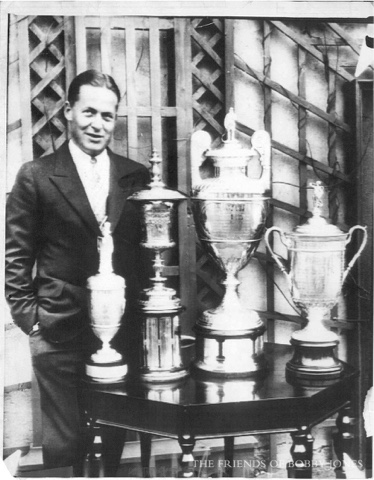Did you know that fate almost intervened to stop Bobby Jones from winning the Grand Slam? Bobby Jones had two close brushes with death between July and September of his Grand Slam year. It might have looked as though the golfing gods had other ideas.
At East Lake, Bobby got caught in a thunder storm. A lightning bolt crashed into the tenth fairway as Bobby was on the twelfth hole, some forty yards away. Bobby felt a tingle in his golf spikes and he and his companions, along with their caddies, decided it was time to leave. As they were leaving the green, another lightning bolt hit a tree at the back of the thirteenth tee. Bobby wrote in his book Golf is my Game: "It struck exactly where we should have been, had we been a minute or so earlier."
As they were now rushing for the clubhouse, Bobby described what happened next:
"As we hurried across the driveway in front of the club on our way to the locker-room entrance, we were dazed by a monstrous explosion, as a heavy bolt hit a big double chimney immediately above our heads. I did not feel a thing, except somehow my umbrella had suddenly collapsed and draped around my head. When I got into the clubhouse, someone discovered that the back of my shirt had been ripped down to my waist and I had received on my shoulder a scratch some six inches in length and just deep enough to break the skin.
After the storm we found the spot where we had been hit littered with masses of brick and mortar, any one of which could have killed a man had it struck him on the head. Fragments of the chimney had been blasted as far as the eighteenth green, which, upon pacing off the distance, I found to be more than three hundred feet away."
Bobby's second close brush with death came a few weeks later. Bobby was walking from his lawyer's office to a luncheon engagement. He was proceeding along the sidewalk on Carnegie Way when he later wrote:
"I must have been thinking about something far removed from the scene, because I was aware of nothing until, having reached a point about midway between the corner and the club entrance, I heard a voice behind me call, 'Look out, Mister.' Startled, I turned quickly and saw an automobile actually mounting the kerb headed directly towards me. I made a broad jump that would have done credit to Jesse Owens, and the automobile crashed into the wall of the clubhouse, having passed exactly over the spot from which I had jumped. There was no doubt that I would have been crushed between the automobile and the building had not the lone pedestrian warned me.
There was no one in the car. Apparently, it had been carelessly parked near the top of the hill some one and a half blocks away."
By now, Bobby was feeling a bit concerned as he had one more mountain to climb, in the form of the U.S. Amateur championship, to win the Grand Slam. He wrote:
"By this time I was beginning to see that there might be many things other than missed putts to interfere with the completion of the Grand Slam. I began to wonder what other things might happen and how I might protect myself against them. I could think of only two against which any sort of safeguard might be erected.
I had heard of one prominent golfer, I believe it was Craig Wood, who had been forced to withdraw from a golf tournament because he had impulsively snatched out of the air a bare razor blade he had dropped in the act of shaving. I resolved to still my normal reflexes during the morning session in the bathroom, so that if I dropped a razor blade, I should be prepared to let the blamed thing fall.
I thought, too, of seeing a photograph of myself leaping across the Swilcan Burn on the first hole at St Andrews during the play of the British Open Championship of 1927. At this point, I thought, I can deny myself the privilege of inviting a sprained ankle by any such childish carelessness. This was not going to be just one more Amateur Championship. At this point I had made no decision that it would be the last one in which I would compete. Nevertheless, I knew that there would never be another which would present the same opportunity, and it could not be postponed if I happened to be unable to compete on the dates upon which it had been scheduled."
We now know that Bobby arrived at Merion in one piece and won the last leg of his Grand Slam. How did he feel, upon winning it? He wrote:
"When Gene Homans stroked that last putt on Saturday afternoon on the eleventh green and, before the ball had stopped rolling, came with a big smile to shake my hand, all at once I felt the wonderful feeling of release from tension and relaxation that I had wanted so badly for so long a time. I wasn't quite certain what had happened or what I had done. I only knew that I had completed a period of most strenuous effort, and at that at this point, nothing more remained to be done, and that on this particular project, at least, there could never at any time in the future be anything else to do. I am certain that many others have enjoyed this feeling--that the project, no matter what its importance, has been finished, and ahead, at least for a time, lies nothing but rest and cessation of worry."
So, fate did not prevent Bobby from completing the Grand Slam. And, in Bobby's eloquent words, we are helped to understand just how he felt about it. What an amazing story. And this one is true.

























